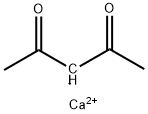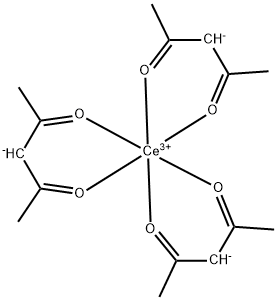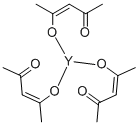Cobaltic acetylacetonate
- CAS NO.:21679-46-9
- Empirical Formula: C15H21CoO6
- Molecular Weight: 356.26
- MDL number: MFCD00013488
- EINECS: 244-527-6
- SAFETY DATA SHEET (SDS)
- Update Date: 2025-01-27 09:38:02

What is Cobaltic acetylacetonate?
Chemical properties
solid
The Uses of Cobaltic acetylacetonate
Catalyst for olefins, diens, polyesters, combustion, solid propellants; polymerization; vulcanizing; coloring for synthetic resins; deposition of metal and/or oxide as memory storage for computers; intermediate for synthesis; glass tinting.
The Uses of Cobaltic acetylacetonate
Cobalt(III) 2,4-pentanedionate is used as a polymerization catalyst, vulcanizing agent, pigment in resins and glass. It is also used for the preparation of monoporphyrinates. Further, it is used in kinetic studies of iron-sulfur proteins. In addition to this, it reacts with trimethylaluminum to prepare Me(Sub>3Al/Co(acac)3.
Flammability and Explosibility
Not classified
Purification Methods
Recrystallise it from *C6H6/pet ether and dry it in a vacuum. [Charles & Pawlikowski J Phys Chem 62 440 1938, Beilstein 1 H 783.]
Properties of Cobaltic acetylacetonate
| Melting point: | 210-213 °C(lit.) |
| Boiling point: | 150°C 1mm |
| Density | 1,43 g/cm3 |
| vapor pressure | 0Pa at 20℃ |
| storage temp. | Store below +30°C. |
| solubility | 3g/l |
| form | crystal |
| color | green |
| Specific Gravity | 1.418 |
| Water Solubility | Soluble in methanol and halogenated solvents. Slightly soluble in acetone, aromatic solvents and aliphatic solvents. Insoluble in water. |
| Sensitive | Moisture Sensitive & Hygroscopic |
| BRN | 9007210 |
| Stability: | Stable. Incompatible with strong oxidizing agents. May decompose on exposure to moist air or water. |
| NIST Chemistry Reference | Cobalt, tris(2,4-pentanedionato-o,o')-(21679-46-9) |
| EPA Substance Registry System | Cobalt, tris(2,4-pentanedionato-.kappa.O,.kappa.O')-, (OC-6-11)- (21679-46-9) |
Safety information for Cobaltic acetylacetonate
| Signal word | Danger |
| Pictogram(s) |
 Health Hazard GHS08 |
| GHS Hazard Statements |
H317:Sensitisation, Skin H334:Sensitisation, respiratory |
| Precautionary Statement Codes |
P261:Avoid breathing dust/fume/gas/mist/vapours/spray. P280:Wear protective gloves/protective clothing/eye protection/face protection. P342+P311:IF experiencing respiratory symptoms: call a POISON CENTER or doctor/physician. |
Computed Descriptors for Cobaltic acetylacetonate
New Products
Indole Methyl Resin tert-butyl 9-methoxy-3-azaspiro[5.5]undecane-3-carboxylate Boc-His(Boc)-OH 2-CTC Resin 4-Chloro-7-tosy1-7Hpyrrolo[2,3-d]pyrimidine 5,7-Dibromo-1H-indole 2,5-dichloro-N-hydroxy-4,6-dimethylpyridine-3-carboximidamide 2,2-Dimethoxy-7-azaspiro[3.5]nonane hydrochloride 4-chloromethyl-5-methyl-1,3-dioxol-2-one (DMDO-Cl) R-2-BENZYLOXY PROPIONIC ACID 1,1’-CARBONYLDIIMIDAZOLE 1,1’-CARBONYLDI (1,2-4 TRIAZOLE) N-METHYL INDAZOLE-3-CARBOXYLIC ACID 4-((2-hydroxyethyl)thio)benzoic acid 1-(TERT-BUTOXYCARBONYL)-2-PYRROLIDINONE Methyl 6-methylnicotinate 3-Pyridineacrylic acid tert-Butyl carbazate TETRAHYDRO-2H-PYRAN-3-OL 2-((4-morpholinophenylamino) (methylthio) methylene) malononitrile 3-(4-morpholinophenylamino)-5-amino-1H-pyrazole-4-carbonitrile 2,4-dihydroxybenzaldehyde 1,3-Diethyl-1,3-Diphenylurea Methyl 2-methylquinoline-6-carboxylateRelated products of tetrahydrofuran








You may like
-
 Cobalt(III) 2,4-pentanedionate CAS 21679-46-9View Details
Cobalt(III) 2,4-pentanedionate CAS 21679-46-9View Details
21679-46-9 -
 Cobalt(III) 2,4-pentanedionate CAS 21679-46-9View Details
Cobalt(III) 2,4-pentanedionate CAS 21679-46-9View Details
21679-46-9 -
 Cobalt(III) 2,4-pentanedionate CAS 21679-46-9View Details
Cobalt(III) 2,4-pentanedionate CAS 21679-46-9View Details
21679-46-9 -
 Cobalt(III) acetylacetonate, 98% CAS 21679-46-9View Details
Cobalt(III) acetylacetonate, 98% CAS 21679-46-9View Details
21679-46-9 -
 Tris(2,4-pentanedionato)cobalt(III) CAS 21679-46-9View Details
Tris(2,4-pentanedionato)cobalt(III) CAS 21679-46-9View Details
21679-46-9 -
 Cobalt(III) acetylacetonate CAS 21679-46-9View Details
Cobalt(III) acetylacetonate CAS 21679-46-9View Details
21679-46-9 -
 Cobalt(III) acetylacetonate CAS 21679-46-9View Details
Cobalt(III) acetylacetonate CAS 21679-46-9View Details
21679-46-9 -
 Cobalt(III) acetylacetonate CAS 21679-46-9View Details
Cobalt(III) acetylacetonate CAS 21679-46-9View Details
21679-46-9
Statement: All products displayed on this website are only used for non medical purposes such as industrial applications or scientific research, and cannot be used for clinical diagnosis or treatment of humans or animals. They are not medicinal or edible.
